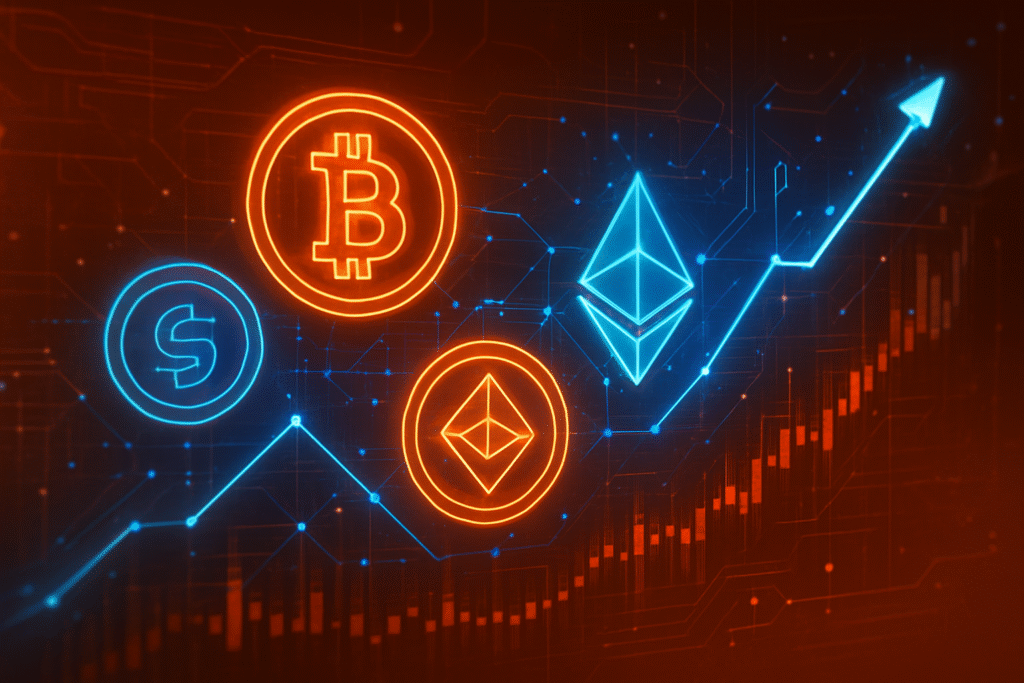
October 31, 2025 – The cryptocurrency landscape is undergoing a profound transformation as a new generation of altcoins emerges, armed with innovative technologies and specialized use cases that are increasingly challenging the long-held market dominance of Bitcoin (BTC) and Ethereum (ETH). This shift, accelerating throughout 2024 and 2025, is driven by significant advancements in scalability, interoperability, and focused applications across decentralized finance (DeFi), non-fungible tokens (NFTs), and Web3 infrastructure. The immediate market response has been a noticeable diversification of investment portfolios and a surge of development activity beyond the two largest cryptocurrencies, signaling a maturing ecosystem where niche solutions and high-performance networks are gaining significant traction.
This evolving competitive landscape is not merely a cyclical "alt season" but rather a fundamental re-evaluation of blockchain capabilities and utility. As the crypto world pushes for broader mainstream adoption, the limitations of early blockchain designs—particularly concerning transaction speed, cost, and cross-chain communication—have become more apparent. Altcoins are stepping into this void, offering solutions that promise to unlock new paradigms of efficiency and functionality. This matters immensely for the crypto ecosystem as it fosters a more resilient, innovative, and user-friendly environment, potentially paving the way for Web3's mass adoption and a truly decentralized digital economy.
Market Impact and Price Action
The period leading up to late 2025 has seen a dynamic shift in market capitalization distribution, with several altcoins demonstrating remarkable resilience and growth, often outpacing Bitcoin and Ethereum during specific windows. While Bitcoin (BTC) continues to hold its position as the primary store of value and Ethereum (ETH) remains the backbone of a vast DeFi and NFT ecosystem, the aggregate market cap of altcoins has steadily gained ground. This is partly due to the influx of institutional capital, which, after initially focusing on BTC and ETH spot ETFs (e.g., the approval of Ethereum spot ETFs in July 2024), has begun to diversify into more specialized and high-growth altcoin projects.
Specific price movements have been particularly notable for Layer 2 solutions and alternative Layer 1s. Projects like Solana (SOL), known for its high transaction speed and low fees, have seen substantial investor interest, especially following strategic partnerships, such as with Western Union, and the launch of Solana-based spot ETFs from Bitwise and Grayscale. Similarly, leading Layer 2 solutions such as Arbitrum (ARB) and Optimism (OP) have shown strong performance, benefiting from increased adoption as Ethereum users seek more cost-effective and faster transaction environments for their DeFi and NFT activities. Their price action often correlates with periods of high network congestion on Ethereum Layer 1, demonstrating their value proposition.
Trading volumes for these high-performing altcoins have surged, indicating robust liquidity and growing market confidence. Technical analysis reveals that many altcoins have successfully broken through key resistance levels, establishing new support zones, and suggesting a sustained bullish outlook for projects with strong fundamentals and clear roadmaps. While past "alt seasons" were often characterized by speculative bubbles, the current trend appears to be more fundamentally driven, with investors increasingly discerning about projects offering genuine technological innovation and solving real-world problems. The comparison to past events suggests a maturation of the market, where utility and adoption are becoming more significant drivers than pure hype.
Community and Ecosystem Response
The crypto community's sentiment regarding the future of altcoins is overwhelmingly positive, marked by vibrant discussions across social media platforms like X (formerly Twitter) and Reddit. There's a palpable excitement about the potential for specialized blockchains and Layer 2 solutions to onboard the next billion users into Web3. Crypto influencers and thought leaders frequently highlight projects that are pushing the boundaries of scalability, interoperability, and user experience, often emphasizing the necessity of a multi-chain future rather than a winner-take-all scenario. The narrative has shifted from merely comparing altcoins to Bitcoin and Ethereum, to recognizing their complementary roles in building a more robust and diverse decentralized ecosystem.
The effects on related DeFi protocols, NFT projects, and Web3 applications have been transformative. Layer 2 solutions have significantly reduced transaction costs and increased speeds, making DeFi more accessible and attractive to a wider user base. Protocols built on or leveraging these scalable altcoin networks, such as Aave (AAVE), Uniswap (UNI), and Synthetix (SNX), have seen increased activity and innovation. NFT projects are also benefiting from cheaper minting and trading fees on alternative Layer 1s like Solana and Polygon (MATIC), fostering a more inclusive and dynamic digital art and collectibles market. Furthermore, the rise of interoperability protocols like Cosmos's (ATOM) Inter-Blockchain Communication (IBC) and LayerZero is enabling seamless asset and data transfer across disparate chains, leading to the emergence of truly multi-chain applications that were previously unimaginable. This interconnectedness is driving a new wave of innovation across the entire Web3 stack.
What's Next for Crypto
The short-term implications for the crypto market suggest continued diversification of investment and development, with a strong focus on projects that deliver tangible utility and solve existing blockchain limitations. We can expect sustained growth in Layer 2 ecosystems, as Ethereum continues its sharding implementation and ZK-rollup technologies mature. Alternative Layer 1s that have proven their scalability and security will likely attract further developer talent and user adoption. In the long term, the rise of altcoins points towards a future where a multitude of specialized blockchains co-exist and interoperate, each optimized for specific use cases, rather than a single dominant chain. This modular blockchain approach, pioneered by projects like Celestia (TIA), could lead to unprecedented levels of scalability and customization.
Potential catalysts to watch include further institutional adoption of altcoin-specific investment products, regulatory clarity that favors innovation while ensuring consumer protection, and breakthroughs in user-friendly Web3 interfaces that abstract away blockchain complexities. The continued development of Real-World Asset (RWA) tokenization, often facilitated by projects like Chainlink (LINK), will also be a significant driver, bridging traditional finance with the blockchain world. Strategic considerations for projects involve prioritizing interoperability, security, and developer experience, while investors should focus on thorough due diligence, assessing a project's technological merit, team, community, and economic model. Possible scenarios range from a continued gradual erosion of BTC/ETH dominance by a diverse array of altcoins to a more pronounced "flippening" event for specific sectors, with the latter becoming increasingly plausible for certain use-case specific altcoins.
Bottom Line
For crypto investors and enthusiasts, the key takeaway is that the market is evolving beyond a simple binary choice between Bitcoin and Ethereum. The burgeoning altcoin ecosystem represents a frontier of innovation, offering diverse opportunities for both technological advancement and investment returns. While Bitcoin and Ethereum will undoubtedly remain foundational pillars, the long-term significance of altcoins lies in their ability to expand the capabilities of blockchain technology, making it more scalable, interconnected, and applicable to a broader range of real-world problems. This diversification is crucial for the long-term health and resilience of the entire crypto space.
Ultimately, this means a significant step forward for crypto adoption. As altcoins address critical pain points like high fees and slow transactions, they lower the barrier to entry for new users and businesses, fostering a more inclusive and efficient digital economy. Important metrics to monitor include the total value locked (TVL) in various Layer 2 solutions, the number of active users on alternative Layer 1s, the growth of cross-chain transaction volumes, and the continued pace of institutional investment into diversified crypto funds. The next few years promise to be a fascinating period of innovation and growth, as the altcoin revolution continues to unfold.
This article is for informational purposes only and does not constitute financial or investment advice. Cryptocurrency investments carry significant risk.





